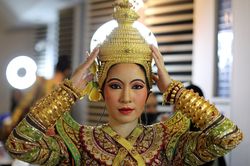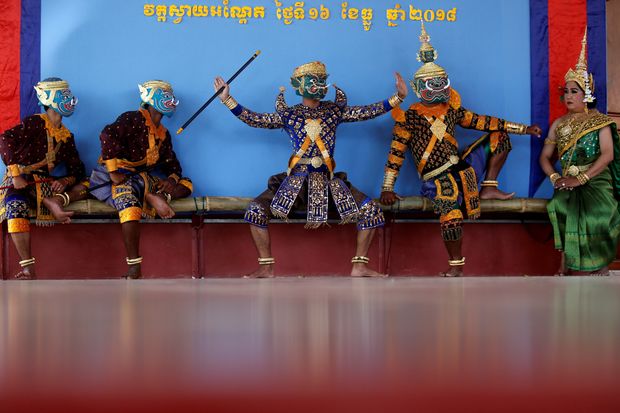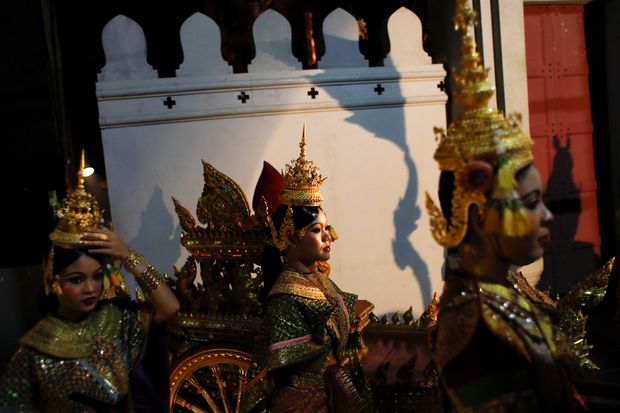
PHNOM PENH/BANGKOK: Cambodia's centuries-old tradition of masked dance was nearly wiped out by the Khmer Rouge's "Killing Fields" regime, but a handful of artists managed to keep it alive and are now working to pass it along to a new generation.
Sun Rithy's father and grandfather were both performers of the Lakhon Khol masked dance, but the ultra-Maoist Khmer Rouge -- who scorned most art as decadent -- banned its study when he was a child in the 1970s.
Now 48, Sun Rithy leads one of the last Lakhon Khol troupes in Cambodia, made up of about 20 performers and students aged six to 15. For him, teaching a new generation is a matter of survival for the tradition.
"I don't want Lakhon Khol ... to go extinct," Sun Rithy told Reuters.

A dancer poses backstage before a performance at the Thailand Cultural Centre in Bangkok on Nov 7 last year.
Lakhon Khol was recently listed by Unesco, the United Nations' cultural agency, as intangible cultural heritage, along with neighbouring Thailand's version of the dance, known as khon.
There are different variations in Southeast Asia, all featuring dancers wearing elaborate painted masks depicting the Ramayana, a Sanskrit epic poem in which a prince rescues his wife from a demon with help from an army of monkeys.
But in Cambodia, the art form is still struggling to recover from the Khmer Rouge, under whose genocidal 1975-79 rule at least 1.7 million people, including artists, dancers and writers, died, mostly from starvation, overwork, disease, execution or torture.
"In the Khmer Rouge, I was young and they didn't teach people to dance. Lakhon Khol was destroyed," said Sun Rithy, who started to learn the dance when he was 14, after the Khmer Rouge were ousted from power.
Reuters video
Ahead of a recent rehearsal, students stretched their legs and hands at the troupe's a newly built theatre at Wat Svay Andet, a Buddhist temple outside the capital, Phnom Penh.
Pum Pork, 49, said his 11-year-old son, Pum Meta, was attending the dance class.
"I want to have my son trained to perform so that in the future we won't lose the ancient art," he said.
Cambodian Minister of Culture and Fine Arts Phoeurng Sackona said that the dance needed immediate preservation and urged all people to get involved.
"Elderly performers are trying to preserve the dance at this Wat Svay Andet," Phoeurng Sackona told Reuters. "But it is up to young people whether they agree or not to receive knowledge from the elders."

Dancers perform 'Lakhon Khol' at the Wat Svay Andet temple in Kandal province, Cambodia, on Dec 16 last year. (Reuters photo)
Thailand's version of the dance has fared better than its neighbour's, but practitioners still depend on recruiting a new generation of performers.
Thailand's khon tradition, originally centred on the royal court, is now taught by many schools and universities.
ML Pongsawad Sukhasvasti, 67, has followed his father's footstep in making Khon masks since he was 10 and still hand-fashions the masks from his home studio in Ayutthaya province, north of Bangkok.
Each mask takes a month to produce, from moulding the plaster to drawing the intricate details.
ML Pongsawad said the Unesco listing could boost awareness.
"Teachers now must do more than teaching the dance," he said. "They need to help students understand the roots as well to preserve it."

Dancers perform Lakhon Khol at the Wat Svay Andet Buddhist temple in Kandal province, Cambodia, on Dec 16 last year. (Reuters photo)